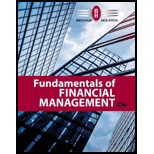
To Determine: Whether the
Introduction: Leverage is the utilization of debt by an organization to finance its operations and extension projects with an end goal to produce an return for investors. Organizations that forcefully utilize debt financing are measured profoundly leveraged and commonly riskier to invest.
Explanation of Solution
The reasons on whether the preferred stock be categorized as debt or equity and the reasons on whether the categorization is prepared by firm's administration, creditors or by the equity investors is as follows:
The preferred stock is categorized simply when the one undertaking the categorization is measured. From the point of view of the firm, preferred stock resembles equity in that it cannot compel the firm into liquidation, yet it resembles debt in that it source changes in profit accessible to the common stockholders. Subsequently, if the firm is apprehensive basically with existence, it would most categorize preferred stock as equity. Nonetheless, if there is basically no risk of insolvency or bankruptcy, the administration would see preferred stock as essentially another fixed charge bond and regard it inside as debt.
The equity investors would have a comparable perspective, and all in all they should look after the preferred stock in much indistinguishable way from debt. As far as creditors are concerned, the position is switched. They take inclination over preferred investors, and the preferred issues go about as a pad. Thus, a bond expert would likely need to regard preferred as equity. Clearly, in every one of these claims, there would need to be a few capabilities, in a stringent logic, preferred stock is either considered as a debt or as an equity, however it is considered as hybrid.
Want to see more full solutions like this?
Chapter 20 Solutions
Fundamentals of Financial Management (MindTap Course List)
- solve this problem qn ??arrow_forwardWhich of the following is not an investment grade credit rating?* BB+ BBB+ BBB BBB-arrow_forwardCompany A has a capital structure of $80M debt and $20M equity. This year, the company reported a net income of $17M. What is Company A's return on equity?* 117.6% 21.3% 85.0% 28.3%arrow_forward
- Principles of Accounting Volume 1AccountingISBN:9781947172685Author:OpenStaxPublisher:OpenStax College
 EBK CONTEMPORARY FINANCIAL MANAGEMENTFinanceISBN:9781337514835Author:MOYERPublisher:CENGAGE LEARNING - CONSIGNMENT
EBK CONTEMPORARY FINANCIAL MANAGEMENTFinanceISBN:9781337514835Author:MOYERPublisher:CENGAGE LEARNING - CONSIGNMENT  Managerial AccountingAccountingISBN:9781337912020Author:Carl Warren, Ph.d. Cma William B. TaylerPublisher:South-Western College Pub
Managerial AccountingAccountingISBN:9781337912020Author:Carl Warren, Ph.d. Cma William B. TaylerPublisher:South-Western College Pub Financial Reporting, Financial Statement Analysis...FinanceISBN:9781285190907Author:James M. Wahlen, Stephen P. Baginski, Mark BradshawPublisher:Cengage Learning
Financial Reporting, Financial Statement Analysis...FinanceISBN:9781285190907Author:James M. Wahlen, Stephen P. Baginski, Mark BradshawPublisher:Cengage Learning Cornerstones of Financial AccountingAccountingISBN:9781337690881Author:Jay Rich, Jeff JonesPublisher:Cengage Learning
Cornerstones of Financial AccountingAccountingISBN:9781337690881Author:Jay Rich, Jeff JonesPublisher:Cengage Learning





